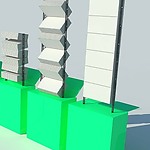Per person, we put out 15 tons of CO2 per year. Normally this would be released into the air. Plants would take in the CO2 and turn it into oxygen thanks to photosynthesis, but what if CO2 was collected and converted into actual solid matter. The Arizona State University claims it’s possible, although it might create more problems than that it would solve.
A concept design shows a box with a big sail made of plastic resin attached to it. When air flows through the sail, CO2 binds with the plastic. When the plastic is made wet, the CO2 is released and can be stored. This way it could be used as fuel for greenhouses to feed plants. An effective way to use CO2, but this wouldn’t solve the climate problem. To fight global warming, we need to get rid of the CO2 by solidifying it. This is where the first problem appears. Where do we store it?
Perhaps it could be used as building material, but it would need the right material properties. It shouldn’t be harmful to people, like some toxic materials are. It also needs structural strength. These are all properties we can only hope for. A more effective way would be to store it in a safe and stable environment.
Donald Penman is a geologist from the University of Yale. His first suggestion: dump it into the ocean. It could be a possible solution, but nobody knows for sure what would happen next. Unforeseen side effects might appear, like sea life being endangered. It might effectively even raise the sea level in the same way global warming is doing it now, making it effectively useless.
Another concept idea shows trees harvesting CO2 and transforming it into energy. These “Boston Treepods” would use solar power through the day to collect CO2 and use the energy from the CO2 to emit light at night. The question is how effective it will be. Why not just plant a regular tree for example?
A nice idea, but the implementation raises questions. The Arizona State University claims it could be a tool of a larger tool set. Perhaps it could be someday.


